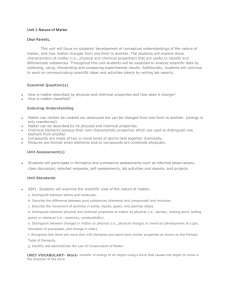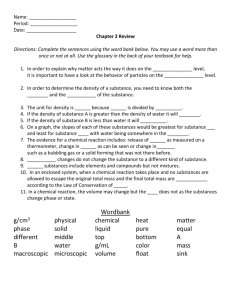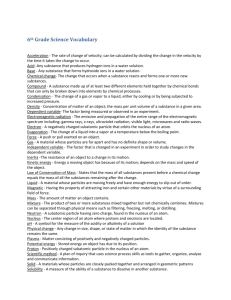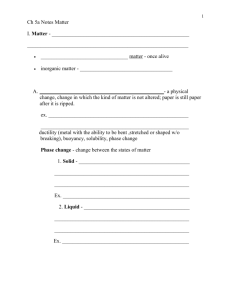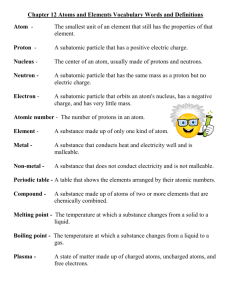Unit 2 Vocabulary Material- a type of solid matter used to make
advertisement
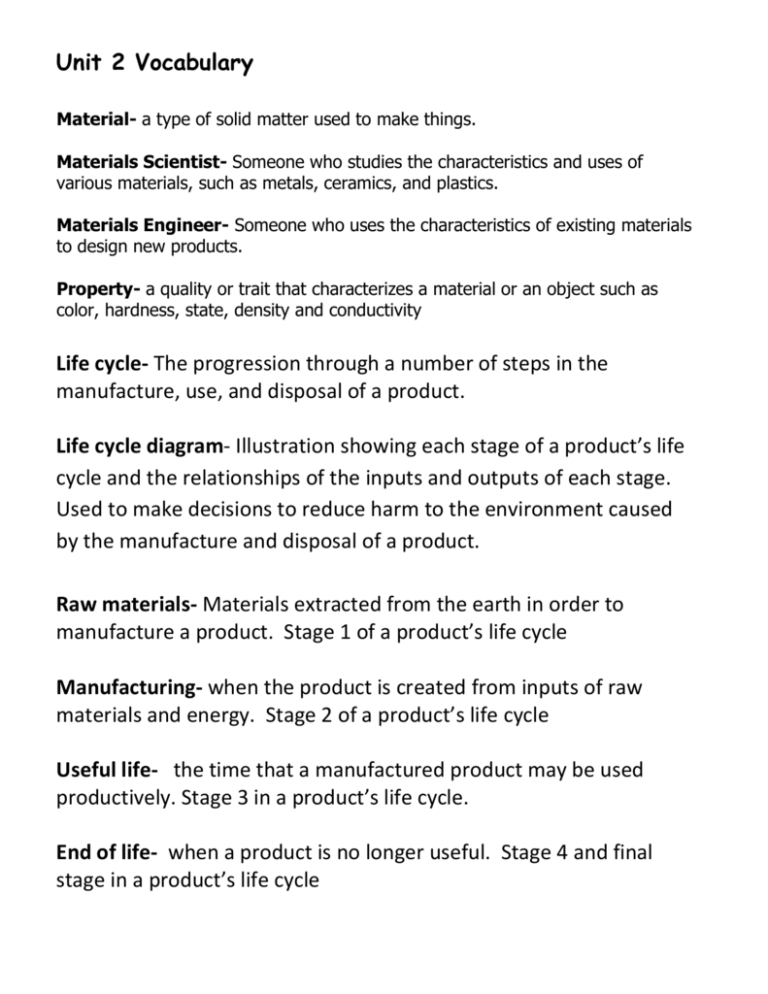
Unit 2 Vocabulary Material- a type of solid matter used to make things. Materials Scientist- Someone who studies the characteristics and uses of various materials, such as metals, ceramics, and plastics. Materials Engineer- Someone who uses the characteristics of existing materials to design new products. Property- a quality or trait that characterizes a material or an object such as color, hardness, state, density and conductivity Life cycle- The progression through a number of steps in the manufacture, use, and disposal of a product. Life cycle diagram- Illustration showing each stage of a product’s life cycle and the relationships of the inputs and outputs of each stage. Used to make decisions to reduce harm to the environment caused by the manufacture and disposal of a product. Raw materials- Materials extracted from the earth in order to manufacture a product. Stage 1 of a product’s life cycle Manufacturing- when the product is created from inputs of raw materials and energy. Stage 2 of a product’s life cycle Useful life- the time that a manufactured product may be used productively. Stage 3 in a product’s life cycle. End of life- when a product is no longer useful. Stage 4 and final stage in a product’s life cycle Atom The basic structural unit of matter; the smallest particle of an element that can enter into a reaction. Atomic mass The average mass of atoms of an element, it also known as atomic weight given in units called atomic mass unit (amu) Element A substance that cannot be broken down into simpler substances by heating it or causing it to react with other chemicals. There are 90 naturally occurring elements in our world and about 25 more created in a laboratory. Family A grouping of elements based on similar chemical properties. Families are generally arranged by columns in the periodic table. Metal Category of elements that usually have a shiny surface, are generally good conductors of heat and electricity, and can be melted or fused, hammered into thin sheets, or drawn into wires. Periodic table of elements An arrangement of the elements according to their atomic numbers so that elements with similar properties are in the same column. In 1869, Dmitri I. Mendeleev designed the first periodic table to show the similarities and differences of the elements. chemical formula A shorthand way to describe elements and compounds and their reactions. Reactions are represented as equations with an arrow indicating direction of change instead of an equal sign. For example, the reaction between hydrochloric acid and sodium hydroxide to produce water and sodium chloride is represented by HCl + NaOH H2O + NaCl. compound A pure substance composed of two or more different elements that are chemically combined and present in definite proportions. For example, H2O contains two atoms of hydrogen and one atom of oxygen chemically combined to produce a new substance with properties different from hydrogen or oxygen. molecule The smallest particle of an element or compound that displays the properties of the substance in quantity. electron An negatively charged particle(s) found outside the center of the nucleus of an atom. It is exactly opposite in electrical charge to a proton but is almost 2,000 times smaller in mass. It is called a subatomic particle. neutron A particle having the same mass as a proton but no electric charge. It is in the center (nucleus) of an atom. proton The positively charged particle(s) contained in the center of an atom. The number of protons determines what element it is which equals its atomic number. Nucleus The center of an atom containing protons and neutrons Electron Cloud The region around the nucleus of an atom where electrons are found Chemical Bond- an electrical attraction between atoms (elements) that forms a molecule (compound) Plastic Substance manufactured from petroleum that can be molded, shaped, dyed into any product. cross-link A process in which chemical links are set up between polymer chains. monomer “one part”. The small molecules that form the units in a polymer chain. polymer “many parts”. Many small molecular units bonded to form a molecule with at least 1,000 atoms. Natural substances such as cellulose, proteins, and rubber are classified as polymers, as are all synthetic plastics. product (of a chemical reaction) The substances that are produced by the reactants. The final substances that are present at the end. reactant The original substances that are present at the beginning of a reaction. Chemical reaction- a chemical change which forms new substances. Example: reactants → product The chemical reaction 2H2 + O2 → 2H2O describes the formation of water from its elements. polymerization The act of chemically bonding many basic units (monomers) together. recycling the collection and treatment of a waste product for use as a raw material in the manufacture of the same (closed loop recycling) product or another product (open loop recycling). circuit board A thin plate which electrically connects computer chips and other electronic components. The connecting pathways are etched in copper and laminated onto a non-conductive material. etch A chemical process using a corrosive solution to make a design in a material by dissolving the material not wanted. concentration The amount of one substance in another substance. The more matter present per unit volume, the more concentrated the substance. control A group in a scientific experiment where the factor being tested is not applied so that it may serve as a standard for comparison against another group where the factor is applied. dilution producing a less concentrated solution by adding water. indicator A substance that can be used to demonstrate whether or not another substance is present. parts per million (ppm) The number of parts of a specific substance per million parts of the total mixture or solution in which it is contained. serial dilution A step by step process of adding water to a given amount of waste to lower the concentration. Closed system A chemical reaction that occurs in a container that allows no reactants or products to escape. Conservation of Mass Mass is neither created nor destroyed during a chemical reaction. Exothermic reaction A chemical reaction characterized by the production and release of heat. Open system A chemical reaction that occurs so that reactants or products are allowed to escape. Mass The amount of matter in an object. Combustion A chemical reaction that takes place when a carbon-containing fuel source is ignited in the presence of oxygen Incineration The burning of wastes at very high temperatures- greater than 650◦ C (1,200◦ F) resulting in the complete combustion of wastes. Reclaim Retrieve discarded material so it can be used again for its original purpose. Precipitate: a deposit of solid particles settled out of a solution. Filtrate Material, especially liquid, that has passed through a filter. Filtration physical separation of one part of a solution from another

